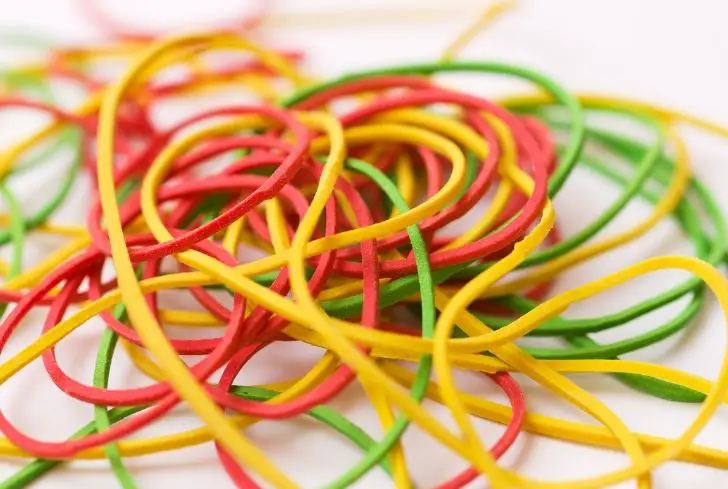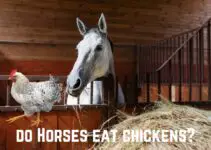Rubber bands are useful utility accessories. We use them to tie our hairs, wrap them around easter eggs, and around remote controls for protection. But in a split second, rubber bands can move from being protective tools to harmful items.
Dogs, especially pups, are curious and eager to test new things, including those not edible. It’s also not surprising that they would chew rubber bands, which could be harmful to them.
If you’ve got yourself a curious little buddy that gnaws on anything it sees, you might want to be more careful about where you keep your rubber bands. In this article, you’ll find helpful tips that will show you what to do if your dog ate a rubber band.
Contents
What Should You Do if Your Dog Ate a Rubber Band?
Smaller rubber bands are less likely to harm your dog because they are easier to remove. There could be an issue if your dog has ingested a larger rubber band. You should contact your veterinarian at work.
If you’re unsure whether your dog ate a rubber band, consult a veterinarian. He might suggest that you wait patiently for the dog to poop it out. That is not often the case.
Can Dogs Poop Out Rubber?
If the rubber band is small, your dog is likely to pass it out as stool without complications. The dog should pass the rubber band in a day or two. You may have to sift through the poop to ensure that the rubber is out.
However, if your dog swallows a big band of rubber, it may block its intestines and might be life-threatening. In such a circumstance, evaluation by a vet is the best solution because a gastrointestinal blockage can be fatal if left untreated.
Can Dogs Digest Rubber?
No, rubbers are not digestible. Your dog will either vomit the rubber or pass it out in its stool. One little rubber band swallowed by a medium or large-sized dog is unlikely to cause harm. The little rubber band will almost certainly pass through your pet’s digestive system without issue.
If your dog is a smaller breed, the rubber band may pose a choking threat or become caught in its intestines, resulting in an intestinal blockage. Because this is a medical emergency, you must contact the veterinarian right away.
If a larger dog consumed a high quantity of rubber bands, it may become unwell or develop an intestinal blockage. A rubber ball can also fatally choke your dog or get stuck in the dog’s stomach, resulting in peritonitis and an abdomen infection.
Can a Dog Die From Eating a Rubberband?
Your dog is unlikely to die from eating a rubber band. However, it might be life-threatening if the rubber band gets stuck in your dog’s stomach. Although rubber bands are non-toxic, they are not easily digestible, unlike acids, alkalis, and petroleum compounds. Depending on the size of rubber swallowed, your dog might choke or have its intestines blocked if it eats a rubber band.
Additionally, a clogged digestive tract leads to a deadly bacterial illness termed peritonitis. In some cases, an obstruction blocks the dog’s intestines killing the surrounding tissue, a condition called necrosis.
How to Prevent Your Dog From Swallowing a Rubber Band?
The following steps can help you prevent your dog from swallowing rubber band:
- Keep easily ingested items out of reach. Rubber bands, hair ties, cigarettes, socks, food wrappers, fruit pips, tampons all fall into this category.
- When your dogs are chewing on toys or goodies, keep an eye on them. If you are too busy to do this, you can tell your kids or neighbors to help you keep an eye on them.
- It is important to get rid of chew toys or rawhide bones that have shrunk enough to fit in your dog’s mouth.
- Regularly dispose of the garbage can and reduce your dog’s access to it.
- Close doors or use baby gates to keep your dog from entering certain areas.
- Secure cabinet doors with baby-proof locks.
- While walking your dog on a leash, keep an eye on him. Along the route, many pets will discover appealing things to eat on the ground.
- Remove or safely store rubber bands, twine, and other things that dogs can swallow.
Besides rubber bands, does your dog try to eat everything it sees? Here are 5 tips to stop your dog from eating everything.
Tip 1: Use slow feed bowls
Dogs are generally energetic, charging at things they see. What if you could train them to slow down a bit, particularly when eating? Slow feed bowls can do that. These special bowls feature a protrusion that forces dogs to work a bit to access their food.
Due to the effort required to eat, your dog’s eating process will slow down. As an added advantage, these bowls also provide mental stimulation for your dog. When used over an extended period, your dog would form the habit of eating slowly.
Tip 2: Don’t tempt them
Hunting is part of every dog’s nature. Though they don’t search for other animals, they often hunt for objects to play with and possibly eat. You can stop them from hunting by keeping harmful items such as rubber bands in less obvious areas.
This applies to other objects that may threaten your dog’s well-being if they mess around and swallow it. So, help your dog by keeping harmful objects far from its reach.
Tip 3: Reward your dog for paying attention
This tip works best when you take your dog outdoors for walks. The outdoors offers your dog so much to see, smell, and possibly eat. So, you’ll need something to keep your dog focused. One way to block out distractions is by giving your dog amazing treats when it looks at you.
Offer irresistible treats such as a piece of steak to keep your dog in check. When your dog learns these treats only come when you’re outside taking walks, it will check in for such treats instead of going after the rubbish littered around.
Tip 4: Get a trainer
In some cases, having a professional train your dog might do the trick. Dogs can be a bit stubborn at times, refusing to listen to you when you want them to let go of harmful objects. However, with a strong “leave it” cue, your dog will listen when you command it to let go of potentially harmful objects.
Tip 5: Use muzz Poisoning les in extreme cases
If you’ve tried everything you possibly can and you’ve failed, a muzzle might be the final solution. Your dog doesn’t have to be aggressive before you consider going for a muzzle.
If your dog constantly puts its life in danger by eating everything, then physically preventing it from ingesting every object is a good option. Muzzles can prevent your dog from eating rubber bands, rocks, worms, and other items that could harm it.
Signs That Your Dog Has Eaten a Rubber Band or Another Dangerous Object
It is critical to be aware of signs that your dog may have eaten a potentially deadly object. Here are some key indications and symptoms to look out for:
- Choking
- Hiccups
- Vomiting
- Frequently licking lips
- Refusing to eat food.
- Abdominal pain or swelling
- Diarrhea
- Restlessness
Emergency Measures If Your Dog Eats a Rubber Band
Look for foreign objects in your dog’s mouth if it’s choking on something. Check the roof of the mouth, gums, and tongue for any signs of decay or infection. A rubber band or string trapped between teeth can be swallowed in part. Consult a veterinarian as soon as possible.
No matter what you see hanging from your dog’s mouth or throat, do not try to take it out or cut it. The dog’s throat, esophagus, or other sensitive internal structures may be damaged as a result. Only attempt to remove a rubber band or other string if it has not been partially swallowed and is easily removable.
What Will The Veterinary Doctor Do To Your Dog?
To determine and treat a probable foreign object in the digestive system, your veterinarian may use a variety of methods, including the following:
- Suppressing or sedating your dog and then removing whatever is in the dog’s mouth or throat
- Inducing vomiting to get rid of the item
- The use of radiographs to determine whether your dog swallowed an object, what it swallowed, and if the object is blocking your dog’s digestive tract
- Using ultrasound or endoscopic inspection to see if the object swallowed will pass through the dog’s digestive tract without veterinary intervention
- Using an endoscopic removal process or another type of extraction to retrieve an object without harming the esophagus; and
- During gastrointestinal surgery, the vet may remove significant parts of the dog’s colon to get rid of a larger object or an object in the intestinal tract. These surgeries can be exceedingly dangerous are only advised in the most critical circumstances. Some dogs may not survive.
Can Dogs Eat Rubber Bands?
No, dogs cannot eat rubber bands. If your dog does, it should excrete it within a day or two. However, if your dog begins to exhibit symptoms like vomiting, loss of appetite, or diarrhea, contact your veterinarian immediately.
It’s nearly impossible to get a dog to stop mouthing things. However, keeping an eye on your dog as they munch on goodies and removing potentially dangerous items from their environment can help to ensure their safety.







